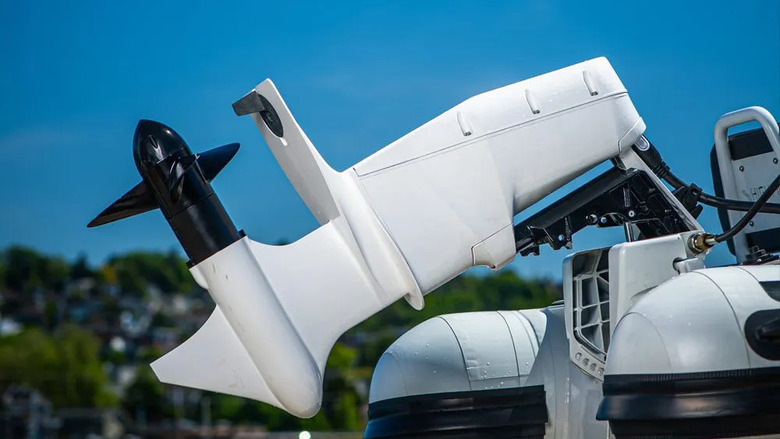GM's EV Roadmap Is Getting Wet
General Motors is wading into boating, splashing out on a 25% stake in a US EV firm specializing in electric boat propulsion systems. Pure Watercraft is a Seattle-based company that developed a zero-emissions outboard motor which is not only near-silent, but requires no maintenance either.
The Pure Outboard system looks, at first glance, like a traditional gas outboard motor. However the unit – equivalent to a regular 50 horsepower outboard – can muster 25 kW of electric power, with power tilt/trim and a 16-inch prop.
With 8.8 kWh battery packs and a Bluetooth-enabled throttle, it can be mounted to the back of an existing boat. Up to ten batteries can be linked together at a time, for longer distance cruising or bigger vessels. "Our fully-sealed electric outboard motor means there are no fluids to ever check or fill," Pure Watercraft adds, "no spark plugs, no cooling loop to get clogged and carry invasive species, no gear set rebuilding, and no annual winterization."
Preorders for the Pure Outboard are already open, with the system priced at $16,500 with a single battery or $25,000 with two battery packs. The company is also offering preorders on fully configured boats, combining its outboard technology with vessels from other brands. For example, a Sun Tracker 20 DLX Party Barge clocks in at $28,500 all-in, while the popular Tracker Pro Team 175 TXW Bass Boat is $27,500.
GM, meanwhile, has until now been focused on land for its applications of electrification. The company is busily working on its first production Ultium-based models, built on its new modular platform for EVs. The first example of that will be the GMC Hummer EV, shortly followed by the Cadillac Lyriq. It's part of a $35 billion investment into EVs and autonomous vehicles that General Motors has committed through 2025.
The appeal of Pure Watercraft, however, is expanding electrification beyond the automotive segment. "The collaboration will leverage Pure Watercraft's innovative marine propulsion technology and experience in the commercial marine industry with GM's engineering, supply chain and manufacturing capabilities," GM said in a statement. "The two companies will develop and commercialize battery electric watercraft, integrating GM technology into a variety of applications, helping to accelerate the industry's transition to electric mobility."
It's unclear at this stage just how much GM paid for its 25% cut of Pure Watercraft. Similarly unknown is exactly what products the two companies have in mind. Those specifics, GM says, will be discussed at a later date.

Still, it's not an entirely outlandish prospect for a car company. The market for electric boats has been growing, albeit relatively slowly, as the same advantages that EV drivetrains demonstrate on land have been turned to show their strengths on water, too. Back in 2018, for example, Jaguar applied electrification to a prototype speedboat, setting a maritime speed record in the process.
More recently, Swedish boat-maker X Shore revealed its first electric model for the US market. The Eelex 8000 – dubbed "the Tesla of electric boats" – can manage up to 35 knots from its 225 kW motor, while dual 60 kWh li-ion batteries are good for up to 100 miles of range according to the company. That doesn't come cheap, mind: the distinctively-styled boat carries a heady $329,000 starting price.
Pure Watercraft, in contrast, significantly undercuts that, not least because it's not trying to build the whole vessel itself. That might make the prospect a lot more appealing – and attainable – to those looking to give their existing boat an electric upgrade, much in the way that GM's long-term plan with Ultium is to offer a compelling upgrade route to those looking to retire their internal combustion cars and trucks.
